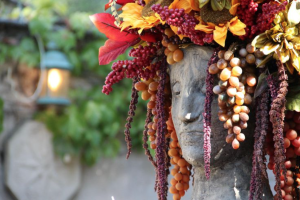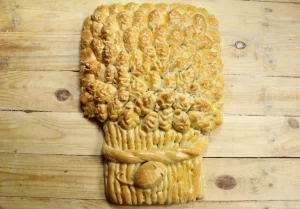Lammas or Lughnasadh is a Wiccan festival celebrated on August 1st in the Northern Hemisphere. For the Southerners, these times remarks the Imbolc. But let’s get back to Lammas marks the beginning of the harvest season and is a time to give thanks for the bounty of the earth. Lughnasadhis was named after the Celtic god Lugh, who was associated with the sun, harvest, and craftsmanship.
Origin of Lughnasadh
The Pagan Wheel of Time is based on the ancient agricultural and solar festivals of pre-Christian Europe. It consists of eight seasonal festivals: Yule (December 20 – 23), Imbolc (February 2), Ostara (March 19 – 22), Beltane (May 1), Lithia (June 19 – 23), Lughnasadh or Lammas (August 1), Mabon (September 21 – 24), and Samhain (November 1).
In ancient times, Lughnasadh was a time of great feasting and celebration. The first grains of the harvest were threshed and baked into bread. Then people share it with family and friends. Lammas was also a time for rituals and magic, as people sought to honor the gods and ensure a successful harvest. Today, Wiccans celebrate Lughnasadh by gathering together to give thanks for the blessings of the earth. They perform rituals to honor the sun, the earth, and the god Lugh.
The origins of Lughnasadh can be traced back to pre-Christian times. Back then it was a harvest festival. With the spread of Christianity, Lammas was transformed into a Christian holiday known as “Lammas Day,”. Lammas day was also a celebration of the first harvest of wheat.
How To Celebrate Lughnasadh Festival
Northern Hemisphere celebrates the Lughnasadh festival on August 1st. It is a time to celebrate the first harvest of the season and give thanks for the abundance of the earth. Here are some ways to celebrate Lughnasadh:
Gather with friends and family
Lughnasadh is traditionally a time for community and sharing. Invite loved ones to a potluck feast or gather together for a picnic in nature.
Bake bread
Bread is a symbol of the harvest and is a staple food in many cultures. Bake a loaf of bread or make some rolls to share with others.
Make a corn dolly
In some traditions, a corn dolly is made from the last sheaf of corn harvested from the fields. The corn dolly is then saved until the next harvest to ensure a successful crop.
Offer gratitude
Take time to reflect on the abundance in your life and offer thanks to the earth, the sun, and any deities or spirits you may work with. You can begin by setting up a sacred space, perhaps with candles, crystals, and offerings of grains, fruits, and herbs. Gathering with loved ones and sharing a feast is also a perfect choice.
Lughnasadh Colors
View this post on Instagram
Lughnasadh’s vibrant hues ignite the festivities. Adorn yourself with the passionate embrace of golden yellows, rustic oranges, and earthy browns. Weave them into your attire, altars, and decorations to honor the bountiful harvest and the Celtic sun god Lugh.
Perform a ritual
Create a ritual that honors the themes of the festival, such as the harvest, abundance, and community. You can light candles, burn incense, and make offerings. You may also choose to meditate, reflect, and give thanks to the gods and goddesses who have provided for you.
Connect with nature
Spend time in nature, whether it’s going for a walk in the woods or sitting outside in your garden. Take in the sights, smells, and sounds of the season.

Harvest herbs or flowers
If you have an herb garden or flower bed, harvest some of the plants to use in spells or for cooking. Some of the herbs commonly associated with Lughnasadh include meadowsweet, sage, sunflower, rosemary, and chamomile.
Make a harvest altar
Create an altar with symbols of the harvest, such as fresh fruits and vegetables, sunflowers, and grains.
Remember that the most important thing is to celebrate in a way that feels authentic and meaningful to you. Lughnasadh is a time to honor the cycles of nature and the bounty of the earth, so find ways to connect with these themes in your way.
What Is Lughnasadh Stones?
It is a time to celebrate the first harvest of the season and give thanks for the abundance of the earth. Several stones are traditionally associated with Lughnasadh and can be used in rituals or spells during the festival.
Carnelian
Carnelian is the stone of the sun and vitality. That makes it a perfect choice for Lughnasadh. It can help bring energy and motivation to achieve goals.
Peridot
This is the stone of abundance and prosperity. It can help attract wealth and success.
Citrine
This yellow stone symbolizes the sun and abundance. It can help bring prosperity and abundance into your life.
Amber
Amber is the sun and warmth. It can help bring happiness, strength, and vitality.
Tiger’s Eye
This brown and gold stone is the stone of protection and grounding. It can help bring clarity and focus to your intentions.
These stones can be used in a variety of ways during Lughnasadh, such as carrying them with you, incorporating them into altars, or using them in rituals and spells. Whether you believe in the spiritual properties of these stones or simply appreciate their beauty, they can be a meaningful way to connect with the themes of the festival and honor the abundance of the earth.


[…] Lughnasadh (Lammas) […]
[…] (February 1 – 6), Ostara (March 19 – 22), Beltane (May 1), Lithia (June 19 – 23), Lughnasadh or Lammas (August 1), Mabon (September 21 – 24), and Samhain (November […]